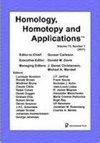$1$-smooth pro-$p$组和Bloch-Kato pro-$p$组
IF 0.5
4区 数学
Q2 MATHEMATICS
引用次数: 0
摘要
设p是素数。一个亲$p$群$G$是$1$-光滑的,如果它能被赋予一个形式为$G \到1 + p \mathbb{Z}_p$的亲$p$群的同态,满足Hilbert 90的正式版本。根据Kummer理论,包含$p$阶$1$根的域的极大pro - $p$伽罗瓦群,与切环性一起,是$1$-光滑的。证明了一个有限生成的解析pro - $p$群是$1$光滑的,当且仅当它是一个包含$p$阶的$1$根的域的最大pro - $p$伽罗瓦群。这对De Clercq-Florence的“光滑猜想”给出了一个肯定的回答,该猜想指出,对于有限生成的$p$-进解析亲$p$群,范数剩余同态的满射性(即Bloch-Kato猜想的“满射一半”)从$1$-光滑开始。本文章由计算机程序翻译,如有差异,请以英文原文为准。
$1$-smooth pro-$p$ groups and Bloch–Kato pro-$p$ groups
Let $p$ be a prime. A pro‑$p$ group $G$ is said to be $1$-smooth if it can be endowed with a homomorphism of pro‑$p$ groups of the form $G \to 1 + p \mathbb{Z}_p$ satisfying a formal version of Hilbert 90. By Kummer theory, maximal pro‑$p$ Galois groups of fields containing a root of $1$ of order $p$, together with the cyclotomic character, are $1$-smooth. We prove that a finitely generated padic analytic pro‑$p$ group is $1$-smooth if, and only if, it occurs as the maximal pro‑$p$ Galois group of a field containing a root of $1$ of order $p$. This gives a positive answer to De Clercq–Florence’s “Smoothness Conjecture” — which states that the surjectivity of the norm residue homomorphism (i.e., the “surjective half” of the Bloch–Kato Conjecture) follows from $1$-smoothness — for the class of finitely generated $p$-adic analytic pro‑$p$ groups.
求助全文
通过发布文献求助,成功后即可免费获取论文全文。
去求助
来源期刊
CiteScore
1.10
自引率
0.00%
发文量
37
审稿时长
>12 weeks
期刊介绍:
Homology, Homotopy and Applications is a refereed journal which publishes high-quality papers in the general area of homotopy theory and algebraic topology, as well as applications of the ideas and results in this area. This means applications in the broadest possible sense, i.e. applications to other parts of mathematics such as number theory and algebraic geometry, as well as to areas outside of mathematics, such as computer science, physics, and statistics. Homotopy theory is also intended to be interpreted broadly, including algebraic K-theory, model categories, homotopy theory of varieties, etc. We particularly encourage innovative papers which point the way toward new applications of the subject.

 求助内容:
求助内容: 应助结果提醒方式:
应助结果提醒方式:


